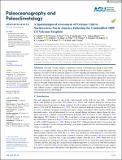A spatiotemporal assessment of extreme cold in northwestern North America following the unidentified 1809 CE volcanic eruption
Abstract
Two large volcanic eruptions contributed to extreme cold temperatures during the early 1800s, one of the coldest phases of the Little Ice Age. While impacts from the massive 1815 Tambora eruption in Indonesia are relatively well-documented, much less is known regarding an unidentified volcanic event around 1809. Here, we describe the spatial extent, duration, and magnitude of cold conditions following this eruption in northwestern North America using a high-resolution network of tree-ring records that capture past warm-season temperature variability. Extreme and persistent cold temperatures were centered around the Gulf of Alaska, the adjacent Wrangell-St Elias Mountains, and the southern Yukon, while cold anomalies diminished with distance from this core region. This distinct spatial pattern of temperature anomalies suggests that a weak Aleutian Low and conditions similar to a negative phase of the Pacific Decadal Oscillation could have contributed to regional cold extremes after the 1809 eruption.
Citation
Leland , C , D’Arrigo , R , Davi , N , Anchukaitis , K J , Andreu-Hayles , L , Porter , T J , Galloway , T , Mant , M , Wiles , G , Wilson , R , Beaulieu , S , Oelkers , R , Gaglioti , B , Rao , M P , Reid , E & Nixon , T 2023 , ' A spatiotemporal assessment of extreme cold in northwestern North America following the unidentified 1809 CE volcanic eruption ' , Paleoceanography and Paleoclimatology , vol. 38 , no. 5 , e2022PA004581 . https://doi.org/10.1029/2022PA004581
Publication
Paleoceanography and Paleoclimatology
Status
Peer reviewed
ISSN
2572-4517Type
Journal article
Description
Funding: This research was funded by the National Science Foundation (NSF) Arctic Social Science (Grants 2112463 and 2112314). KJA was supported by NSF AGS-1501834 and AGS-2102993. RD, KA, LAH, and BVG were supported by NSF OPP #2124885. GW and BVG were supported by NSF P2C2 #2002561. TJP was supported by NSERC Discovery Grant RGPIN-2016-06730. RW was supported by NERC project #NE/S000887/1. MPR was supported by NOAA Climate and Global Change Postdoctoral Fellowship Program, UCAR-CPAESS award #NA18NWS4620043B and EU2020 Marie Skłodowska-Curie Grant 101031748.Collections
Items in the St Andrews Research Repository are protected by copyright, with all rights reserved, unless otherwise indicated.

